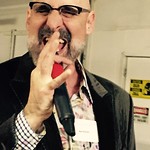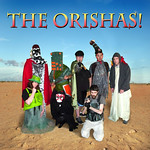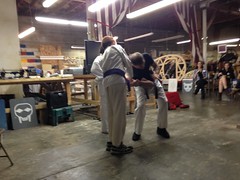ASN Presents: Financial Planning for Special Needs
Posted By Janet Lawson, MFT on August 6, 2015
The Autistry Support Network is pleased to invite you to attend a special panel discussion on Financial Planning for Special Needs to be held at Autistry Studios’ new location.
Date: Thursday, August 27, 2015
Time: 7pm to 8:30 pm
Where: Autistry Studios, 448 Du Bois Street, San Rafael (Directions)
**REGISTRATION REQUIRED** RSVP to Barbara Waite.
Parents must plan carefully to provide the best future possible for their children with special needs. Most families want to maximize their child’s eligibility for government programs like SSI and Medi-Cal, but also want to use tools like Special Needs Trusts to maintain a certain standard of living for their child. During this panel discussion, experts from various fields will address questions such as:
• How might a Special Needs Trust be used most effectively in an estate plan? Is the ABLE Act a useful tool?
• How do I know if I have set aside enough assets for my child, and how should these assets be invested?
• How should I think about naming a family member versus corporate trustee for my Special Needs Trust?
• Under what circumstances should I consider using insurance to fund my child’s Special Needs Trust?
• Under what conditions should I consider a limited conservatorship for my child?
ASK AHEAD OF TIME! What are your most pressing questions about financial planning for your Autistry student? What do you wish you knew?
Send questions to Susan Ansberry.
Our panelists will be:
[ezcol_1third] Jennifer Cunneen, an attorney specializing in estate planning. Jennifer advises individuals, families and closely held businesses on estate planning, family foundations and other wealth-transfer related issues. Jennifer earned her BS and JD from Santa Clara University, where she graduated cum laude. Jennifer works with many families with special needs children, including establishing special needs trusts and limited conservatorships, which is a very gratifying part of her law practice. She enjoys her free time with her family, and her community involvement with the Rotary and other nonprofits. Jennifer is a mother to two children, including her son Nick who is on the autism spectrum.
Jennifer Cunneen, an attorney specializing in estate planning. Jennifer advises individuals, families and closely held businesses on estate planning, family foundations and other wealth-transfer related issues. Jennifer earned her BS and JD from Santa Clara University, where she graduated cum laude. Jennifer works with many families with special needs children, including establishing special needs trusts and limited conservatorships, which is a very gratifying part of her law practice. She enjoys her free time with her family, and her community involvement with the Rotary and other nonprofits. Jennifer is a mother to two children, including her son Nick who is on the autism spectrum.
[/ezcol_1third]
[ezcol_1third] Greg Finn, the Trust Relationship Manager for Fremont Bank’s Trust Department, which specializes in serving as trustee for family’s Special Needs Trusts (SNTs). Greg has over 30 years of experience in the financial services industry, the last 10 years focusing on SNTs. He and his team help family members with bill paying, investment of trust assets, public benefits, estate planning and tax planning. Greg has a BSC in Finance and an MBA from Santa Clara University and is a graduate of Cannon Financial Institute’s Special Needs Trusts School.
Greg Finn, the Trust Relationship Manager for Fremont Bank’s Trust Department, which specializes in serving as trustee for family’s Special Needs Trusts (SNTs). Greg has over 30 years of experience in the financial services industry, the last 10 years focusing on SNTs. He and his team help family members with bill paying, investment of trust assets, public benefits, estate planning and tax planning. Greg has a BSC in Finance and an MBA from Santa Clara University and is a graduate of Cannon Financial Institute’s Special Needs Trusts School.
[/ezcol_1third]
[ezcol_1third_end] Karen Park, a Principal at Bernstein and a mother to three boys, including one who has complex special needs. Karen joined Bernstein in 2004 and is based in the firm’s San Francisco office. She advises high-net-worth families regarding their investment plans, wealth transfer goals and related issues. Prior to joining Bernstein, Karen was a vice president with Morgan Stanley’s technology investment banking team and a financial analyst with CS First Boston. She earned a BA, magna cum laude, in social studies from Harvard University and an MBA from Harvard Business School.
Karen Park, a Principal at Bernstein and a mother to three boys, including one who has complex special needs. Karen joined Bernstein in 2004 and is based in the firm’s San Francisco office. She advises high-net-worth families regarding their investment plans, wealth transfer goals and related issues. Prior to joining Bernstein, Karen was a vice president with Morgan Stanley’s technology investment banking team and a financial analyst with CS First Boston. She earned a BA, magna cum laude, in social studies from Harvard University and an MBA from Harvard Business School.
[/ezcol_1third_end]
What is the Autistry Support Network? The ASN is the booster group for Autistry Studios. It coordinates auxiliary activities such as field trips, speaker events, fundraisers, social get-togethers, and more. If you are the parent or guardian of an Autistry student, congratulations—you are automatically a member of the ASN! There aren’t any dues, but the ASN does provide opportunities to network with other parents who “get it” and the chance to support all Autistry students.




 “Don’t mollycoddle autistic kids”.* How many times have we sat in an audience with other parents, nodding our heads when Temple Grandin gives this advice? After she speaks, we applaud. We get our pictures taken with her, post them on the refrigerator and on our Facebook page. We even get our children to pose with her and hope they will be as successful as she has been. But have we really heard what she is saying, and do we put her advice into practice?
“Don’t mollycoddle autistic kids”.* How many times have we sat in an audience with other parents, nodding our heads when Temple Grandin gives this advice? After she speaks, we applaud. We get our pictures taken with her, post them on the refrigerator and on our Facebook page. We even get our children to pose with her and hope they will be as successful as she has been. But have we really heard what she is saying, and do we put her advice into practice?







 April is Autism Awareness Month: Well, for some of us every month is Autism Awareness Month. But I am all for people learning more about how ASD minds work and what programs work for ASD minds. Thursday, April 2nd, Nicole Hitchcock has organized
April is Autism Awareness Month: Well, for some of us every month is Autism Awareness Month. But I am all for people learning more about how ASD minds work and what programs work for ASD minds. Thursday, April 2nd, Nicole Hitchcock has organized 






























 S and A #3: One of the events that kept us hopping was our third Scientists & Artists…Party! This is one of my favorite events as it brings together amazing talents from many different fields. The party also gives our students a chance to show off their work and mingle with cool people. Dr. Rachel Brem represented the Buck Institute and gave us a fabulous glimpse into the world of research science. She described her work, Finding Genes that Make Fruit Flies Fat, in such a clear, entertaining way that we were all ready to sign up for science class.
S and A #3: One of the events that kept us hopping was our third Scientists & Artists…Party! This is one of my favorite events as it brings together amazing talents from many different fields. The party also gives our students a chance to show off their work and mingle with cool people. Dr. Rachel Brem represented the Buck Institute and gave us a fabulous glimpse into the world of research science. She described her work, Finding Genes that Make Fruit Flies Fat, in such a clear, entertaining way that we were all ready to sign up for science class.  We welcomed a new face to our Autistry extended family, John Hersey. John is considered one of the founders of digital illustration. Though you might not recognize John on the street many of you are familiar with his work. For example the sugar skull sports team illustrations which began when the SF Giants won the World Series in 2010 on the Day of the Dead and John created the now iconic Dia de los Gigantes! He is a great speaker and we look forward to many return appearances at Autistry.
We welcomed a new face to our Autistry extended family, John Hersey. John is considered one of the founders of digital illustration. Though you might not recognize John on the street many of you are familiar with his work. For example the sugar skull sports team illustrations which began when the SF Giants won the World Series in 2010 on the Day of the Dead and John created the now iconic Dia de los Gigantes! He is a great speaker and we look forward to many return appearances at Autistry. A dear friend and longtime Autistry supporter, Cliff Saron gave us a preview of the TEDx talk that he will give in the spring. We were mesmerized as he challenged our understanding of reality and opened up whole new ways of seeing the world. Cliff is a research scientist at the UC Davis Center for Mind and Brain. His work in sensory processing, multisensory integration and contemplative practice sheds light on some of the more complex underlying processes of autism … and neuro-typicalism as well!
A dear friend and longtime Autistry supporter, Cliff Saron gave us a preview of the TEDx talk that he will give in the spring. We were mesmerized as he challenged our understanding of reality and opened up whole new ways of seeing the world. Cliff is a research scientist at the UC Davis Center for Mind and Brain. His work in sensory processing, multisensory integration and contemplative practice sheds light on some of the more complex underlying processes of autism … and neuro-typicalism as well! We also had a demonstration of martial arts by Al Loren and his students, April and Chris. They brought us to our feet cheering the lightning fast fists and the high kicks. And then we raced the remote control cars around the track! And, with the help and talent of Greg Nett, we karaoke’d the night away! We may do another Scientists & Artists…Party in the spring. So stay tuned!
We also had a demonstration of martial arts by Al Loren and his students, April and Chris. They brought us to our feet cheering the lightning fast fists and the high kicks. And then we raced the remote control cars around the track! And, with the help and talent of Greg Nett, we karaoke’d the night away! We may do another Scientists & Artists…Party in the spring. So stay tuned! Entertaining illustrious visitors: Author Rhys Bowen (Royal Spyness Series, The Evan Evans Series and the Molly Murphy Mysteries) toured the studio. Rhys is from Bath, England but now makes her home in Marin County. She has followed the growth of Autistry and donated several signed books for our silent auction. The Autistry Support Network (ASN) is hoping to host a Tea with Rhys in the spring.
Entertaining illustrious visitors: Author Rhys Bowen (Royal Spyness Series, The Evan Evans Series and the Molly Murphy Mysteries) toured the studio. Rhys is from Bath, England but now makes her home in Marin County. She has followed the growth of Autistry and donated several signed books for our silent auction. The Autistry Support Network (ASN) is hoping to host a Tea with Rhys in the spring. The word is getting out about Autistry! Dr. Karen O’Connell, University of Technology, Sydney, Australia was in Berkeley delivering a paper on disability discrimination in the law when someone mentioned the work we do at Autistry. She immediately arranged a visit. We spent a wonderful morning discussing the issues facing our ASD clients as they grow older and go out into the world. Dr. O’Connell is part of an international effort to reexamine legal systems and the institutionalized discrimination of those with disabilities.
The word is getting out about Autistry! Dr. Karen O’Connell, University of Technology, Sydney, Australia was in Berkeley delivering a paper on disability discrimination in the law when someone mentioned the work we do at Autistry. She immediately arranged a visit. We spent a wonderful morning discussing the issues facing our ASD clients as they grow older and go out into the world. Dr. O’Connell is part of an international effort to reexamine legal systems and the institutionalized discrimination of those with disabilities. 



